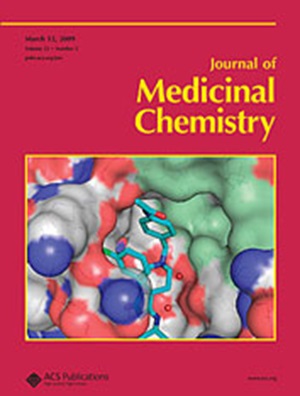Ecdysteroid-Containing Squalenoylated Self-Assembling Nanoparticles Exert Tumor-Selective Sensitization to Reactive Oxygen Species (ROS)-Induced Oxidative Damage While Protecting Normal Cells: Implications for Selective Radiotherapy
IF 6.8
1区 医学
Q1 CHEMISTRY, MEDICINAL
引用次数: 0
Abstract
Central nervous system (CNS) tumors are exceptionally difficult to treat, and oxidative stress-inducing radiotherapy is an important treatment modality. In this study, we examined self-assembling pro-drug nanoconjugates of naturally derived antitumor ecdysteroids, which were designed to interfere with oxidative stress in brain tumor cells. Eight ecdysteroid-squalene conjugates were semi-synthesized and formulated into self-assembled aqueous nanosuspensions, which showed excellent stability for up to 16 weeks. The nanoassemblies demonstrated a strong dose-dependent sensitizing effect to tert-butyl hydroperoxide (tBHP)-induced oxidative damage in SH-SY5Y cells, while exerting a strong protective effect in MRC-5 fibroblast cells. In contrast, free ecdysteroids protected both cell lines from tBHP-induced damage. This suggests an important role for squalenoylation in the antitumor effect and indicates that our conjugates have potential as highly selective adjuvants in radiotherapy by sensitizing cancer cells and protecting surrounding tissues. Furthermore, our findings suggest a potential neuroprotective effect of nonconjugated ecdysteroids.

求助全文
约1分钟内获得全文
求助全文
来源期刊

Journal of Medicinal Chemistry
医学-医药化学
CiteScore
4.00
自引率
11.00%
发文量
804
审稿时长
1.9 months
期刊介绍:
The Journal of Medicinal Chemistry is a prestigious biweekly peer-reviewed publication that focuses on the multifaceted field of medicinal chemistry. Since its inception in 1959 as the Journal of Medicinal and Pharmaceutical Chemistry, it has evolved to become a cornerstone in the dissemination of research findings related to the design, synthesis, and development of therapeutic agents.
The Journal of Medicinal Chemistry is recognized for its significant impact in the scientific community, as evidenced by its 2022 impact factor of 7.3. This metric reflects the journal's influence and the importance of its content in shaping the future of drug discovery and development. The journal serves as a vital resource for chemists, pharmacologists, and other researchers interested in the molecular mechanisms of drug action and the optimization of therapeutic compounds.
 求助内容:
求助内容: 应助结果提醒方式:
应助结果提醒方式:


